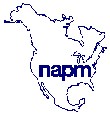 |
North American Prototype Modelers, Ltd. A Milwaukee WI based HO gauge model railroad club |
| Home | Layout | Membership | Pictures | News | Operating Sessions | Contact Us |
Who We Are
Our Purpose North American Prototype Modelers (NAPM) is a
Milwaukee, WI - based HO scale model railroad club
whose members share a simple primary goal: the
creation, maintenance, and enjoyment of one of the
nation's finest model railroads. NAPM's members
are serious modelers dedicated to high standards
of construction, modeling, and operation. The club
was founded in 1977 on the premise that a
well-organized club could yield benefits and
enjoyment unattainable by single modelers or even
small groups. Today, a quarter-century after the
first monthly meetings in the homes of founding
members, NAPM has created a heritage of careful
planning and hard work. The efforts are
culminating in a remarkable railroad located in a
secure and permanent location. The club affords
members of widely varying interests the means to
concentrate on their own modeling interests while
they benefit from close association with members
in other aspects of the hobby. The club's
expectation of high standards of modeling and
conduct is enhanced by a culture of respect,
teaching and sharing. A Permanent Home In 1985, NAPM found what has proven to be the
ideal permanent home situated beneath an
easy-to-reach landmark building in the city of
Milwaukee. The club's quarters are in excess of
five thousand (5,000) square feet and are divided
between layout, meeting room, work, and storage
spaces, all accessible to members "24/365".
Convenient parking and rest room facilities are
provided, and even restaurants of several
varieties are within a short walking distance. The
club's reception area is a faithful replica of a
turn-of-the-century small-town depot. The control
tower, designed to look like a mainline switch
tower, enjoys a vista above the main
classification yard of the layout. From this perch
the dispatcher commands operating sessions. Our LayoutThe layout itself includes over 26 scale miles of Class A track, with two thirds of that comprised of an impressive double-track mainline. A single-track main weaves its way along and around, above and beneath, the double-track section on its way around the layout. A noticeable feeling of progression through the landscape is created by use of floor-to-ceiling space dividers, which separate the many "peninsula aisles" of the road into visually distinct regions. The entire area of the layout is lit using suspended lighting valences. Special features along the right-of-way include:
To see the track plan click here. Back to top Technology NAPM has endeavored from its beginnings to
employ the latest technologies consistent with
reliability and economy. With prototype operation
being its goal, NAPM's electronic experts
implemented early forms of remote walk-around
devices, including experimental hybrids. As newer
forms of electronic controls emerged, and as
standards were embraced by the hobby, NAPM made
careful selections, and is now equipped with
cutting-edge systems that control both trains and
track. The club's layout operates Digital Command
Control (DCC) technology. In order to run on the
NAPM layout, locomotives must be equipped with
special digital decoders. The layout employs a
combination of automatic electronic switch
machines and manually - operated hand throws.
Lighting of many buildings and some important
grounds, such as freight yards and
engine-servicing facilities are being installed.
Night-simulation lighting for the entire layout is
expected in the near future. Our Members NAPM members come from many backgrounds, ages,
and income levels. Though we share a dedication to
the objectives of the club, the diversity among
our membership is the lynch pin of the NAPM's
stability. During the eight years between our
first meeting and the first occupancy of the
present permanent layout location, the members
busied themselves with formation of a corporation,
the forging of enduring rules and standards, and
creation of common expectations for club
government. These efforts became the foundation
for a club that operates relatively free of
disharmony and disagreements. We've agreed to act
by group consensus rather than by individual
incentive. We've attracted mature, intelligent,
serious modelers, who make proposals and seek
accord before making permanent changes to the
layout or premises. Most importantly, NAPM members
are expected to respect not only the property, but
the opinions of every other member. Each member is
expected to contribute to the betterment of the
club in some way, not to simply take from it. Meetings, Obligations, and Admittance Normal activities at NAPM include weekly work
sessions (Thursdays, all evening), monthly
business meetings (third Thursday of each month),
Tuesday-morning work sessions (well-attended by
retired members), and member-only operating
sessions (unpublished schedule). An occasional
Saturday morning work session, called a "blitz",
may be planned to accomplish larger jobs or tasks
needing immediate attention. None of the club's
dates are mandatory sessions. This is a hobby, so
no one can command attendance. Even so, the club's
average monthly participation is very high -
roughly 75% of the currently active members attend
more than one session or event per month. NAPM's
income is derived almost exclusively from monthly
dues, with a much smaller amounts from other
sources, such as donations and initiation fees.
NAPM is a not-for-profit Wisconsin corporation,
and though occasional donations are gratefully
accepted, the members expect to fund their own
club. Annual budgets are formulated and approved
by the membership. The club pays for projects from
pre-approved budgets, so individual members
working on the club's behalf are compensated for
expenses as they're incurred. Applications for
membership from among serious modelers are always
welcome. Persons applying for membership must
complete a probationary period, during which their
personality, skills, aptitudes, participation, and
potential contributions to the club are gauged. At
the end of that period, once eligible for
induction, applicants must again formally request
admittance, and win approval by the full NAPM
membership How To Find Us Please click here
to email an officer for directions. |
Copyright © 2005 NAPM, Ltd.